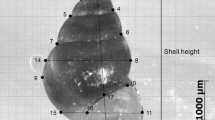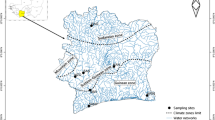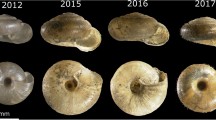Abstract
Wildlife data often show spatial organization, demonstrating positive correlations either as a result of processes occurring over the landscape or due to the influence of spatially structured environmental variables. It is, thus, essential to consider non-random spatial structure when evaluating the underlying causes of biological variation. In this study, we analyzed the population structure of Chilina dombeyana shell morphology of 14 populations that are close geographically and belong to the same hydrographic basin. We utilized a variation partitioning approach to evaluate the importance of spatial processes, such as migration, acting over the landscape, and environmental characteristics, including habitat and hydrologic characteristics, and the occurrence of aquatic predators in promoting between population variation. Our results demonstrate spatially structured variation in C. dombeyana shell morphology, with populations living near each other having more similar shell sizes than populations living farther apart. The shell size variation partition indicated that both spatially structured environmental factors and genetic relationships resulting from migration or shared common ancestry may explain this pattern. Shell shape variation, in contrast, was found to be essentially under the influence of non-spatially structured environmental factors, with habitat and water characteristics accounting for about half of the total variation among populations. The large proportion of the variation in shell size that is spatially structured demonstrates that spatial structure on morphological traits might be strong and highlights the need to consider such phenomenon in intraspecific studies of phenotypic evolution.




Similar content being viewed by others
References
Alexander HJ, Taylor JS, Wu SST, Breden F (2006) Parallel evolution and vicariance in the guppy (Poecilia reticulata) over multiple spatial and temporal scales. Evolution 60:2352–2369
APHA-AWWA-WPCF (1995) Standard methods for the examination of water and wastewater. American Public Health Association, Washington
Bailey RC, Byrnes J (1990) A new, old method for assessing measurement error in both univariate and multivariate morphometric studies. Syst Zool 39:124–130
Bertin A, Inostroza PA, Quinones RA (2009) A theoretical estimation of the concentration of steroid estrogens in effluents released from municipal sewage treatment plants into aquatic ecosystems of central-southern Chile. Sci Tot Env 407:4965–4971
Blanchet FG, Legendre P, Borcard D (2008a) Forward selection of explanatory variables. Ecology 89:2623–2632
Blanchet FG, Legendre P, Borcard D (2008b) Modelling directional spatial processes in ecological data. Ecol Model 215:325–336
Blanchet FG, Legendre P, Maranger R, Monti D, Pepin P (2011) Modelling the effect of directional spatial ecological processes at different scales. Oecologia 166:357–368
Borcard D, Gillet F, Legendre F (2010) Numerical ecology with R. Springer, New York
Cardini A, Elton S (2009) Geographical and taxonomic influences on cranial variation in red colobus monkeys (Primates, Colobinae): introducing a new approach to “morph” monkeys. Global Ecol Biogeogr 18:248–263
Chardon JP, Adriaensen F, Matthysen F (2003) Incorporating landscape elements into a connectivity measure: a case study for the Speckled wood butterfly (Pararge aegeria L.). Landscape Ecol 18:561–573
Claude J (2008) Morphometrics with R. Springer, New York
Cliand AD, Ord JK (1973) Spatial autocorrelation. Pion, London
Cordova S, Gaete H, Aranguiz F, Figueroa R (2009) Water quality assessment in the Limache stream (central Chile), using bioindicators and bioassays. Lat Am J Aquat Res 37:199–209
Debels P, Figueroa R, Urrutia R, Barra R, Niell X (2005) Evaluation of water quality in the Chillán River (Central Chile) using physicochemical parameters and a modified water quality index. Environ Monit Assess 110:301–322
R Development Core Team (2011) R: a language and environment for statistical computing. R Foundation for Statistical Computing
Dewitt TJ, Langerhans RB (2003) Multiple prey traits, multiple predators: keys to understanding complex community dynamics. J Sea Res 49:143–155
Dewitt TJ, Sih A, Hucko JA (1999) Trait compensation and cospecialization in a freshwater snail: size, shape and antipredator behaviour. Anim Behav 58:397–407
Dewitt TJ, Robinson BW, Wilson DS (2000) Functional diversity among predators of a freshwater snail imposes an adaptive trade-off for shell morphology. Evol Ecol Res 2:129–148
Dray S, Legendre P, Peres-Neto PR (2006) Spatial modelling: a comprehensive framework for principal coordinate analysis of neighbour matrices (PCNM). Ecol Model 196:483–493
Figueroa R, Palma A, Ruiz V, Niell X (2007) Comparative analysis of biotic indexes used to evaluate water quality in a Mediterranean river of Chile: Chillan River, VIII Region. Rev Chil Hist Nat 80:225–242
Freeman AS, Meszaros J, Byers JE (2009) Poor phenotypic integration of blue mussel inducible defenses in environments with multiple predators. Oikos 118:758–766
Fruciano C, Tigano C, Ferrito V (2011) Geographical and morphological variation within and between colour phases in Coris julis (L. 1758), a protogynous marine fish. Biol J Linn Soc 104:148–162
Giller PS, Hildrew AG (1994) Patchiness, species interactions, and disturbance in the stream benthos. In: Giller PS, Hildrew AG, Raffaeli DG (eds) Aquatic ecology: scale, pattern and process. Blackwell Science, Oxford, pp 21–62
Gittenberger E, Groenenberg DSJ, Kokshoorn B, Preece RC (2006) Molecular trails from hitch-hiking snails. Nature 439:409
Gittleman JL, Kot M (1990) Adaptation—statistics and a null model for estimating phylogenetic effects. Syst Zool 39:227–241
Grenouillet G, Brosse S, Tudesque L, Lek S, Baraille Y, Loot G (2008) Concordance among stream assemblages and spatial autocorrelation along a fragmented gradient. Divers Distrib 14:592–603
Habit E, Belk MC, Tuckfield RC, Parra O (2006) Response of the fish community to human-induced changes in the Biobío River in Chile. Fresh Biol 51:1–11
Klingenberg CP, McIntyre GS (1998) Geometric morphometrics of developmental instability: analyzing patterns of fluctuating asymmetry with procrustes methods. Evolution 52:1363–1375
Lakowitz T, Bronmark C, Nystrom P (2008) Tuning in to multiple predators: conflicting demands for shell morphology in a freshwater snail. Fresh Biol 53:2184–2191
Legendre P (1993) Spatial autocorrelation—trouble or new paradigm. Ecology 74:1659–1673
Legendre P, Legendre L (1998) Numerical ecology. Elsevier, Amsterdam
Matthews WJ (1998) Patterns in freshwater fish ecology. Chapman & Hall, New York
McRae BH (2006) Isolation by resistance. Evolution 60:1551–1561
Miller MP, Weigel DE, Mock KE (2006) Patterns of genetic structure in the endangered aquatic gastropod Valvata utahensis (Mollusca: Valvatidae) at small and large spatial scales. Fresh Biol 51:2362–2375
Minton RL, Norwood AP, Hayes DM (2008) Quantifying phenotypic gradients in freshwater snails: a case study in Lithasia (Gastropoda: Pleuroceridae). Hydrobiologia 605:173–182
Moran PAP (1950) Notes on continuous stochastic phenomena. Biometrika 37:17–23
Ohta T, Miyake Y, Tsutom H (2011) Light intensity regulates growth and reproduction of a snail grazer (Gyraulus chinensis) through changes in the quality and biomass of stream periphyton. Fresh Biol 56:2260–2271
Orrego R, Adams S, Barra R, Chiang G, Gavilan JF (2009) Patterns of fish community composition along a river affected by agricultural and urban disturbance in south-central Chile. Hydrobiologia 620:35–46
Peres-Neto PR, Legendre P, Dray S, Borcard D (2006) Variation partitioning of species data matrices: estimation and comparison of fractions. Ecology 87:2614–2625
Perez SI, Diniz JAF, Bernal V, Gonzalez PN (2010) Spatial regression techniques for inter-population data: studying the relationships between morphological and environmental variation. J Evol Biol 23:237–248
Potapova MG, Charles DF (2002) Benthic diatoms in USA rivers: distributions along spatial and environmental gradients. J Biogeogr 29:167–187
Rohlf FJ (1990) Rotational fit (Procrustes) method. In: Rohlf FJ, Bookstein FL (eds) Proceedings of the Michigan Morphometrics Workshop University of Michigan, Ann Arbor, pp. 227–236
Rohlf FJ (1999) Shape statistics: procrustes superimpositions and tangent spaces. J Classif 16:197–223
Rohlf FJ (2004) tpsDig
Slice DE (1996) Three-dimensional, generalized resistant fitting and the comparison of least squares and resistant fit residuals. In: Marcus LF, Corti M, Loy A, Naylor GJP, Slice DE (eds) Advances in morphometrics. Plenum Press, New York
Statzner B, Borchardt D (1994) Longitudinal patterns and processes along streams: modelling ecological responses to physical gradients. In: Giller PS, Hildrew AG, Raffaeli DG (eds) Aquatic ecology: scale, pattern and process. Blackwell Scientific Publications, Oxford, pp 113–140
Stone GN, Nee S, Felsenstein J (2011) Controlling for non-independence in comparative analysis of patterns across populations within species. Philos T Roy Soc B 366:1410–1424
Sturges HA (1926) The choice of a class interval. J Am Stat Assoc 153:65–66
Vannote RL, Minshall GW, Cummings KW, Sedell JR, Cushing CE (1980) The river continuum concept. Can J Fish Aquat Sci 37:130–137
Villanueva VD, Albarino R, Modenutti B (2004) Grazing impact of two aquatic invertebrates on periphyton from an Andean-Patagonian stream. Arch Hydrobiol 159:455–471
Wesselingh FP, Cadée GC, Renema W (1999) Flying high: on the airborne dispersal of aquatic organisms as illustrated by the distribution histories of the gastropod genera Tryonia and Planorbarius. Geol Mijnb 78:165–174
Worthington WJ, Elkin C, Wilcox C, Murray L, Niejalkes D, Possingham H (2008) The influence of multiple dispersal mechanisms and landscape structure on population clustering and connectivity in fragmented artesian spring snail populations. Mol Ecol 17:3733–3751
Acknowledgments
We thank Gabriela Mancilla, Mariela Henriquez, Gina Ramirez, and Hugo Benítez de la Fuente for technical assistance; Waldo San Martín, Margarita Marchant, Ernesto Toledo, Domingo Galdame, and Jéssica Bórquez for their help with sample collection; Fernanda Herrera for the drawing of the shell; and Lafayette Eaton and Paul B. Samollow for revising the English of the manuscript. This research was funded by a grant from the Chilean National Research Agency FONDECYT #1090404. NG was also partially supported by the project INNOVA-CORFO #06FC01IBC-71 from the Chilean Agency for Economic Development.
Integrity of research and reporting
The authors declare that they have no conflict of interest and that the experiments comply with the current laws of Chile.
Author information
Authors and Affiliations
Corresponding author
Additional information
Communicated by: Sven Thatje
Electronic supplementary material
Below is the link to the electronic supplementary material.
ESM 1
(DOC 203 kb)
Rights and permissions
About this article
Cite this article
Bertin, A., Ruíz, V.H., Figueroa, R. et al. The role of spatial processes and environmental determinants in microgeographic shell variation of the freshwater snail Chilina dombeyana (Bruguière, 1789). Naturwissenschaften 99, 225–232 (2012). https://doi.org/10.1007/s00114-012-0890-8
Received:
Revised:
Accepted:
Published:
Issue Date:
DOI: https://doi.org/10.1007/s00114-012-0890-8




